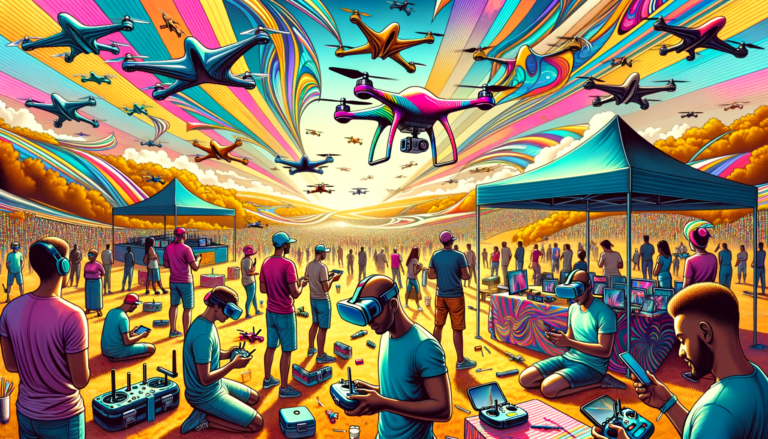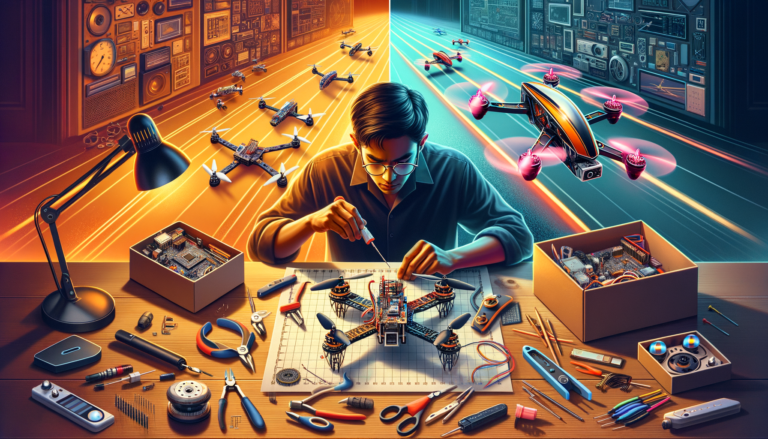Zoom! Whizz! Whoosh! The exhilarating world of drone racing has taken flight, captivating enthusiasts worldwide. Did you know that the global drone racing market is expected to reach $2.08 billion by 2026? That’s some serious growth! But here’s the thing – you don’t need a fancy track or deep pockets to get started. In this guide, we’ll show you how to practice drone racing right in your own backyard, keeping it legal, safe, and incredibly fun. Get ready to elevate your piloting skills and join the ranks of high-flying racers!
Understanding the Basics of Drone Racing
Let’s dive into the exciting world of drone racing! So, what exactly is drone racing, and how does it work? Well, imagine high-speed remote-controlled aircraft zipping through obstacle courses at breakneck speeds. That’s drone racing in a nutshell!
To get started, you’ll need to familiarize yourself with the key components of a racing drone. These typically include a lightweight frame, powerful motors, propellers, a flight controller, and a camera for First Person View (FPV) flying.
Now, what skills do you need to become a successful drone racer? First and foremost, you’ll want to develop excellent hand-eye coordination and spatial awareness. Quick reflexes are a must, as is the ability to think on your feet (or should I say, in the air?).
One thing that can’t be stressed enough is the importance of practicing at home. It’s like any other sport – the more you practice, the better you’ll become. Plus, it’s a great way to hone your skills without the pressure of competition.
Setting Up Your Backyard Practice Area
Ready to turn your backyard into a drone racing paradise? First things first, let’s assess your available space. You don’t need a massive area, but you’ll want enough room to maneuver your drone safely.
Creating a safe and enclosed environment is crucial. You don’t want your drone zooming off into your neighbor’s yard, do you? Consider using netting or barriers to keep your drone contained.
Now for the fun part – setting up obstacles and gates! Get creative here. You can use hula hoops, PVC pipes, or even cardboard boxes to create your own miniature race course.
Don’t forget about lighting! If you plan on practicing in the evening or early morning, proper lighting is essential. LED strips can be a great, cost-effective solution for illuminating your course.
Choosing the Right Equipment for Home Practice
Selecting the right drone is crucial, especially for beginners. Look for a durable, ready-to-fly model that won’t break the bank. Remember, you’re likely to crash a few times while learning!
Don’t forget about accessories and spare parts. Extra propellers, batteries, and a good charger are must-haves. Trust me, you’ll thank yourself later when you’re in the middle of a great practice session and don’t have to stop because of a broken prop.
When it comes to FPV gear, a good quality headset or goggles are essential. They’ll give you that immersive flying experience that makes drone racing so thrilling.
Lastly, don’t skimp on protective equipment. A good pair of safety glasses and maybe even some gloves can go a long way in preventing injuries.
Legal Considerations for Backyard Drone Racing
Before you start revving up those motors, let’s talk legalities. It’s crucial to understand your local drone laws and regulations. The last thing you want is a knock on the door from local authorities!
In some areas, you might need to obtain permits or licenses for flying drones. It’s worth checking with your local council or aviation authority to make sure you’re in the clear.
Remember to respect your neighbors’ privacy and property. Keep your drone within your property boundaries and avoid flying over other people’s homes without permission.
Lastly, consider getting some insurance for your drone practice. It might seem unnecessary, but it could save you a headache if something goes wrong.
Safety Precautions for Home Drone Racing
Safety first, folks! Establish a pre-flight checklist and stick to it every time. This should include checking your drone’s physical condition, ensuring all connections are secure, and verifying that your controls are responding correctly.
Implementing a buddy system for practice sessions is a great idea. Not only is it more fun to practice with a friend, but they can also keep an eye out for any potential hazards.
Battery safety is crucial in drone racing. Always follow proper charging procedures and never leave batteries charging unattended. It’s also a good idea to have a fire-safe bag for storing and charging your LiPo batteries.
Lastly, develop an emergency response plan. Know what to do in case of a crash, a flyaway, or any other unexpected situation. Being prepared can help prevent minor incidents from becoming major problems.
Effective Drone Racing Practice Techniques
Now, let’s talk about how to make the most of your practice sessions. Start by mastering basic maneuvers and controls. Get comfortable with hovering, basic turns, and simple flight patterns.
Once you’ve got the basics down, focus on precision flying and obstacle navigation. Set up challenging courses in your backyard and practice flying through tight spaces.
Improving your reaction time and spatial awareness is key to becoming a top-notch drone racer. Try setting up timed courses or practicing quick direction changes to sharpen these skills.
To really up your game, try simulating race conditions in your backyard. Set up a start/finish line, create a challenging course, and time your laps. It’s a great way to get a feel for real racing scenarios.
Utilizing Drone Racing Simulators for Home Practice
While real-world practice is essential, don’t overlook the benefits of drone racing simulators. They’re a great way to practice when the weather’s bad or you can’t get outside.
There are several popular drone racing simulators out there. Some fan favorites include DRL (Drone Racing League) Simulator, Liftoff, and Velocidrone. Give them a try and see which one you like best!
Setting up a simulator station at home is easier than you might think. All you need is a decent computer, a controller (many people use their actual drone transmitter), and the simulator software.
The best part about simulators? The skills you develop virtually can transfer to real-world flying. It’s a great way to try out new tricks or courses without the risk of crashing your actual drone.
Tracking Your Progress and Setting Goals
Keep a practice log to track your progress. Note down your flight times, any new skills you’ve mastered, and areas where you need improvement. It’s incredibly satisfying to look back and see how far you’ve come!
Set achievable milestones for skill improvement. Maybe this week you want to master a particular turn, or perhaps you’re aiming to reduce your lap time by a certain percentage.
Many modern drones come with telemetry capabilities. Use this data to analyze your flights and identify areas for improvement. It’s like having a personal coach!
Finally, don’t forget to join online communities for support and advice. There are tons of forums and social media groups dedicated to drone racing. It’s a great way to get tips, share experiences, and maybe even find local racing events. Remember, the drone racing community is generally very welcoming to newcomers, so don’t be shy!
Conclusion
Congratulations! You’re now equipped with the knowledge to turn your backyard into a thrilling drone racing practice arena. Remember, the key to becoming a skilled pilot is consistent practice, patience, and a passion for improvement. As you hone your skills at home, you’ll be amazed at how quickly you progress. Who knows? With dedication and the right approach, you might just find yourself competing in professional drone racing leagues someday! So, what are you waiting for? Grab your drone, head to your backyard, and let the races begin! Happy flying, and may the best pilot win!







